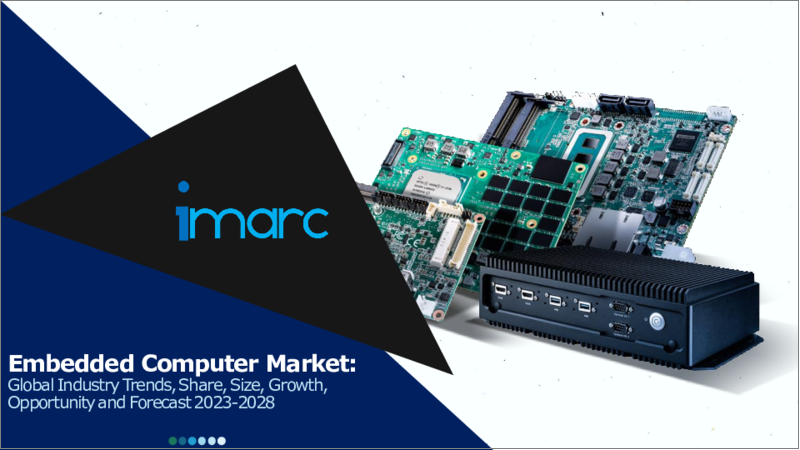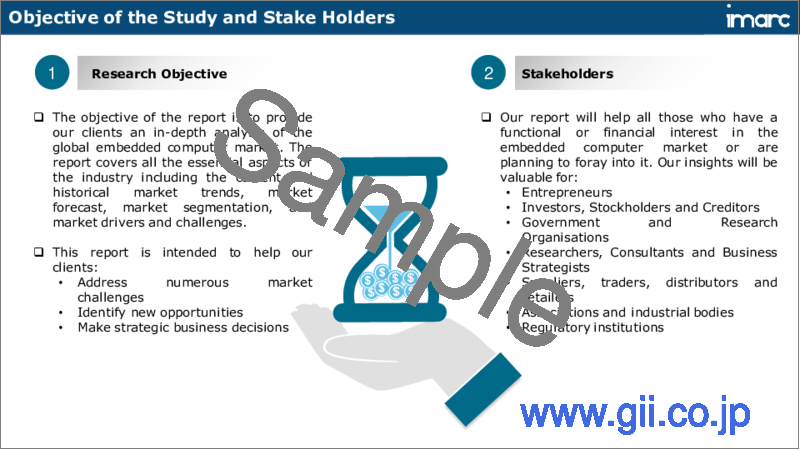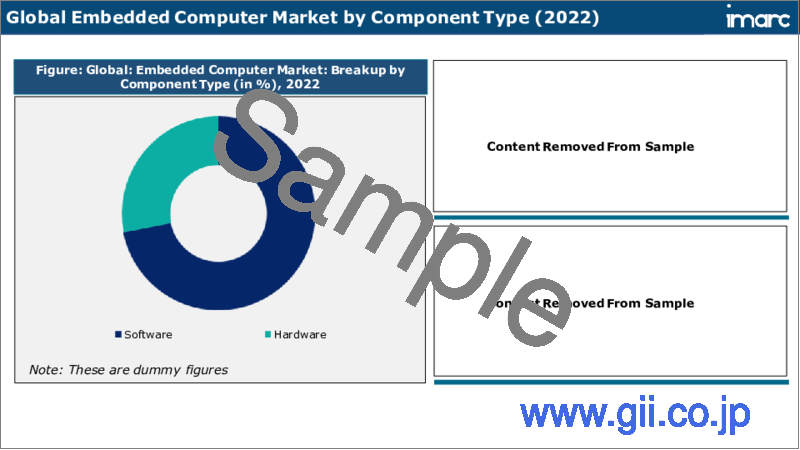|
|
市場調査レポート
商品コード
1378749
組み込みコンピュータ市場:世界の産業動向、シェア、規模、成長、機会、2023-2028年予測Embedded Computer Market: Global Industry Trends, Share, Size, Growth, Opportunity and Forecast 2023-2028 |
||||||
|
● お客様のご希望に応じて、既存データの加工や未掲載情報(例:国別セグメント)の追加などの対応が可能です。 詳細はお問い合わせください。 |
|||||||
| 組み込みコンピュータ市場:世界の産業動向、シェア、規模、成長、機会、2023-2028年予測 |
|
出版日: 2023年11月02日
発行: IMARC
ページ情報: 英文 141 Pages
納期: 2~3営業日
|
- 全表示
- 概要
- 図表
- 目次
概要
世界の組み込みコンピュータ市場規模は、2022年に430億米ドルに達しました。今後、IMARC Groupは、同市場は2028年までに679億米ドルに達し、2022~2028年の成長率(CAGR)は7.9%になると予測しています。
組み込みコンピュータは、リアルタイム・オペレーティング・システム(RTOS)によって制御され、大型の機械や装置内に設置されます。センサーを通じて電子データを受信し、マイクロプロセッサーで処理され、必要なタスクを実行する機械部品に情報を渡します。テレビ、自動車、電話、デジタルカメラ、洗濯機、電子レンジ、食器洗い機などによく使われています。コンパクトで費用対効果が高く、管理が簡単で、従来のコンピューターに比べて性能が向上し、リアルタイムで情報を転送できます。
組み込みコンピュータの市場動向:
組み込みコンピュータは、アンチロック・ブレーキ・システム(ABS)、クルーズ・コントロール、その他乗用車や電気自動車(EV)の主要部品に使用されています。これは、交通死亡事故の増加や、乗客と 促進要因の安全性向上への注目の高まりと相まって、市場成長を後押しする主な要因の一つとなっています。さらに、組み込みコンピュータは、いくつかの慢性疾患の診断と治療のために医療機器に組み込まれています。このことは、慢性疾患の有病率の上昇やヘルスケア・インフラの大幅な改善とともに、市場の成長に寄与しています。また、バッテリー寿命の向上、複数のスポーツモード、健康追跡機能を備えたフィットネスウォッチ、バンド、トラッカーなどのスマートウェアラブルのイントロダクションも、市場の成長に寄与しています。さらに、環境問題やエネルギー安全保障への関心の高まりにより、世界中で再生可能エネルギーの導入が増加しています。これとは別に、モノのインターネット(IoT)と人工知能(AI)を統合してネットワーク経由でデータを送信し、複雑な問題を解決し、機械間(M2M)通信を改善することは、業界プレーヤーに有利な成長機会を提供しています。
本レポートで扱う主な質問
- 2022年の世界の組み込みコンピュータ市場規模は?
- 2023年~2028年の世界の組み込みコンピュータ市場の予想成長率は?
- 世界の組み込みコンピュータ市場を牽引する主要因は何か?
- COVID-19が組み込みコンピューターの世界市場に与えた影響は?
- 組み込みコンピュータの世界市場におけるコンポーネントタイプ別の区分は?
- 組み込みコンピュータの世界市場における最終用途産業別の区分は?
- 組み込みコンピュータの世界市場における主要地域は?
- 組み込みコンピュータの世界市場における主要プレイヤー/企業は?
目次
第1章 序文
第2章 調査範囲と調査手法
- 調査目的
- 利害関係者
- データソース
- 一次情報
- 二次情報
- 市場推定
- ボトムアップアプローチ
- トップダウンアプローチ
- 調査手法
第3章 エグゼクティブサマリー
第4章 イントロダクション
- 概要
- 主要産業動向
第5章 世界の組み込みコンピュータ市場
- 市場概要
- 市場実績
- COVID-19の影響
- 市場予測
第6章 市場内訳:コンポーネントタイプ別
- ソフトウェア
- 市場動向
- 市場予測
- ハードウェア
- 市場動向
- 主要タイプ
- マイクロプロセッサー
- マイクロコントローラー
- デジタルシグナルプロセッサ
- その他
- 市場予測
第7章 市場内訳:最終用途産業別
- 自動車/輸送機器
- 市場動向
- 市場予測
- 産業オートメーション
- 市場動向
- 市場予測
- 情報通信技術
- 市場動向
- 市場予測
- ヘルスケア
- 市場動向
- 市場予測
- ユーティリティ
- 市場動向
- 市場予測
- その他
- 市場動向
- 市場予測
第8章 市場内訳:地域別
- 北米
- 米国
- 市場動向
- 市場予測
- カナダ
- 市場動向
- 市場予測
- 米国
- アジア太平洋
- 中国
- 市場動向
- 市場予測
- 日本
- 市場動向
- 市場予測
- インド
- 市場動向
- 市場予測
- 韓国
- 市場動向
- 市場予測
- オーストラリア
- 市場動向
- 市場予測
- インドネシア
- 市場動向
- 市場予測
- その他
- 市場動向
- 市場予測
- 中国
- 欧州
- ドイツ
- 市場動向
- 市場予測
- フランス
- 市場動向
- 市場予測
- 英国
- 市場動向
- 市場予測
- イタリア
- 市場動向
- 市場予測
- スペイン
- 市場動向
- 市場予測
- ロシア
- 市場動向
- 市場予測
- その他
- 市場動向
- 市場予測
- ドイツ
- ラテンアメリカ
- ブラジル
- 市場動向
- 市場予測
- メキシコ
- 市場動向
- 市場予測
- その他
- 市場動向
- 市場予測
- ブラジル
- 中東・アフリカ地域
- 市場動向
- 市場内訳:国別
- 市場予測
第9章 SWOT分析
- 概要
- 強み
- 弱み
- 機会
- 脅威
第10章 バリューチェーン分析
第11章 ポーターのファイブフォース分析
- 概要
- 買い手の交渉力
- 供給企業の交渉力
- 競合の程度
- 新規参入業者の脅威
- 代替品の脅威
第12章 価格分析
第13章 競合情勢
- 市場構造
- 主要企業
- 主要企業のプロファイル
- Advantech Co., Ltd.
- Arm Limited
- Fujitsu Limited
- Intel Corporation
- International Business Machines Corporation
- Microchip Technology Inc.
- Microsoft Corporation
- Qualcomm Incorporated
- Renesas Electronics Corporation
- Texas Instruments Incorporated
List of Figures
- Figure 1: Global: Embedded Computer Market: Major Drivers and Challenges
- Figure 2: Global: Embedded Computer Market: Sales Value (in Billion US$), 2017-2022
- Figure 3: Global: Embedded Computer Market: Breakup by Component Type (in %), 2022
- Figure 4: Global: Embedded Computer Market: Breakup by End Use Industry (in %), 2022
- Figure 5: Global: Embedded Computer Market: Breakup by Region (in %), 2022
- Figure 6: Global: Embedded Computer Market Forecast: Sales Value (in Billion US$), 2023-2028
- Figure 7: Global: Embedded Computer (Software) Market: Sales Value (in Million US$), 2017 & 2022
- Figure 8: Global: Embedded Computer (Software) Market Forecast: Sales Value (in Million US$), 2023-2028
- Figure 9: Global: Embedded Computer (Hardware) Market: Sales Value (in Million US$), 2017 & 2022
- Figure 10: Global: Embedded Computer (Hardware) Market Forecast: Sales Value (in Million US$), 2023-2028
- Figure 11: Global: Embedded Computer (Automotive/Transportation) Market: Sales Value (in Million US$), 2017 & 2022
- Figure 12: Global: Embedded Computer (Automotive/Transportation) Market Forecast: Sales Value (in Million US$), 2023-2028
- Figure 13: Global: Embedded Computer (Industrial Automation) Market: Sales Value (in Million US$), 2017 & 2022
- Figure 14: Global: Embedded Computer (Industrial Automation) Market Forecast: Sales Value (in Million US$), 2023-2028
- Figure 15: Global: Embedded Computer (Information and Communication Technology) Market: Sales Value (in Million US$), 2017 & 2022
- Figure 16: Global: Embedded Computer (Information and Communication Technology) Market Forecast: Sales Value (in Million US$), 2023-2028
- Figure 17: Global: Embedded Computer (Healthcare) Market: Sales Value (in Million US$), 2017 & 2022
- Figure 18: Global: Embedded Computer (Healthcare) Market Forecast: Sales Value (in Million US$), 2023-2028
- Figure 19: Global: Embedded Computer (Utilities) Market: Sales Value (in Million US$), 2017 & 2022
- Figure 20: Global: Embedded Computer (Utilities) Market Forecast: Sales Value (in Million US$), 2023-2028
- Figure 21: Global: Embedded Computer (Other End Use Industries) Market: Sales Value (in Million US$), 2017 & 2022
- Figure 22: Global: Embedded Computer (Other End Use Industries) Market Forecast: Sales Value (in Million US$), 2023-2028
- Figure 23: North America: Embedded Computer Market: Sales Value (in Million US$), 2017 & 2022
- Figure 24: North America: Embedded Computer Market Forecast: Sales Value (in Million US$), 2023-2028
- Figure 25: United States: Embedded Computer Market: Sales Value (in Million US$), 2017 & 2022
- Figure 26: United States: Embedded Computer Market Forecast: Sales Value (in Million US$), 2023-2028
- Figure 27: Canada: Embedded Computer Market: Sales Value (in Million US$), 2017 & 2022
- Figure 28: Canada: Embedded Computer Market Forecast: Sales Value (in Million US$), 2023-2028
- Figure 29: Asia Pacific: Embedded Computer Market: Sales Value (in Million US$), 2017 & 2022
- Figure 30: Asia Pacific: Embedded Computer Market Forecast: Sales Value (in Million US$), 2023-2028
- Figure 31: China: Embedded Computer Market: Sales Value (in Million US$), 2017 & 2022
- Figure 32: China: Embedded Computer Market Forecast: Sales Value (in Million US$), 2023-2028
- Figure 33: Japan: Embedded Computer Market: Sales Value (in Million US$), 2017 & 2022
- Figure 34: Japan: Embedded Computer Market Forecast: Sales Value (in Million US$), 2023-2028
- Figure 35: India: Embedded Computer Market: Sales Value (in Million US$), 2017 & 2022
- Figure 36: India: Embedded Computer Market Forecast: Sales Value (in Million US$), 2023-2028
- Figure 37: South Korea: Embedded Computer Market: Sales Value (in Million US$), 2017 & 2022
- Figure 38: South Korea: Embedded Computer Market Forecast: Sales Value (in Million US$), 2023-2028
- Figure 39: Australia: Embedded Computer Market: Sales Value (in Million US$), 2017 & 2022
- Figure 40: Australia: Embedded Computer Market Forecast: Sales Value (in Million US$), 2023-2028
- Figure 41: Indonesia: Embedded Computer Market: Sales Value (in Million US$), 2017 & 2022
- Figure 42: Indonesia: Embedded Computer Market Forecast: Sales Value (in Million US$), 2023-2028
- Figure 43: Others: Embedded Computer Market: Sales Value (in Million US$), 2017 & 2022
- Figure 44: Others: Embedded Computer Market Forecast: Sales Value (in Million US$), 2023-2028
- Figure 45: Europe: Embedded Computer Market: Sales Value (in Million US$), 2017 & 2022
- Figure 46: Europe: Embedded Computer Market Forecast: Sales Value (in Million US$), 2023-2028
- Figure 47: Germany: Embedded Computer Market: Sales Value (in Million US$), 2017 & 2022
- Figure 48: Germany: Embedded Computer Market Forecast: Sales Value (in Million US$), 2023-2028
- Figure 49: France: Embedded Computer Market: Sales Value (in Million US$), 2017 & 2022
- Figure 50: France: Embedded Computer Market Forecast: Sales Value (in Million US$), 2023-2028
- Figure 51: United Kingdom: Embedded Computer Market: Sales Value (in Million US$), 2017 & 2022
- Figure 52: United Kingdom: Embedded Computer Market Forecast: Sales Value (in Million US$), 2023-2028
- Figure 53: Italy: Embedded Computer Market: Sales Value (in Million US$), 2017 & 2022
- Figure 54: Italy: Embedded Computer Market Forecast: Sales Value (in Million US$), 2023-2028
- Figure 55: Spain: Embedded Computer Market: Sales Value (in Million US$), 2017 & 2022
- Figure 56: Spain: Embedded Computer Market Forecast: Sales Value (in Million US$), 2023-2028
- Figure 57: Russia: Embedded Computer Market: Sales Value (in Million US$), 2017 & 2022
- Figure 58: Russia: Embedded Computer Market Forecast: Sales Value (in Million US$), 2023-2028
- Figure 59: Others: Embedded Computer Market: Sales Value (in Million US$), 2017 & 2022
- Figure 60: Others: Embedded Computer Market Forecast: Sales Value (in Million US$), 2023-2028
- Figure 61: Latin America: Embedded Computer Market: Sales Value (in Million US$), 2017 & 2022
- Figure 62: Latin America: Embedded Computer Market Forecast: Sales Value (in Million US$), 2023-2028
- Figure 63: Brazil: Embedded Computer Market: Sales Value (in Million US$), 2017 & 2022
- Figure 64: Brazil: Embedded Computer Market Forecast: Sales Value (in Million US$), 2023-2028
- Figure 65: Mexico: Embedded Computer Market: Sales Value (in Million US$), 2017 & 2022
- Figure 66: Mexico: Embedded Computer Market Forecast: Sales Value (in Million US$), 2023-2028
- Figure 67: Others: Embedded Computer Market: Sales Value (in Million US$), 2017 & 2022
- Figure 68: Others: Embedded Computer Market Forecast: Sales Value (in Million US$), 2023-2028
- Figure 69: Middle East and Africa: Embedded Computer Market: Sales Value (in Million US$), 2017 & 2022
- Figure 70: Middle East and Africa: Embedded Computer Market Forecast: Breakup by Country (in %), 2022
- Figure 71: Middle East and Africa: Embedded Computer Market Forecast: Sales Value (in Million US$), 2023-2028
- Figure 72: Global: Embedded Computer Industry: SWOT Analysis
- Figure 73: Global: Embedded Computer Industry: Value Chain Analysis
- Figure 74: Global: Embedded Computer Industry: Porter's Five Forces Analysis
List of Tables
- Table 1: Global: Embedded Computer Market: Key Industry Highlights, 2022 and 2028
- Table 2: Global: Embedded Computer Market Forecast: Breakup by Component Type (in Million US$), 2023-2028
- Table 3: Global: Embedded Computer Market Forecast: Breakup by End Use Industry (in Million US$), 2023-2028
- Table 4: Global: Embedded Computer Market Forecast: Breakup by Region (in Million US$), 2023-2028
- Table 5: Global: Embedded Computer Market Structure
- Table 6: Global: Embedded Computer Market: Key Players
Abstract
The global embedded computer market size reached US$ 43.0 Billion in 2022. Looking forward, IMARC Group expects the market to reach US$ 67.9 Billion by 2028, exhibiting a growth rate (CAGR) of 7.9% during 2022-2028.
An embedded computer is controlled by a real-time operating system (RTOS) and placed within a larger machine or equipment. It receives electronic data through sensors, which are processed by the microprocessor, and passes the information to mechanical components that operate the required task. It is commonly used in television (TV) sets, motor vehicles, telephones, digital cameras, washing machines, microwaves, and dishwashers. It is compact, cost-effective, easy to manage, improves performance, and transfers information in real-time as compared to conventionally used computers.
Embedded Computer Market Trends:
The embedded computer is used in anti-lock braking systems (ABS), cruise control, and other major components of passenger and electric vehicles (EVs). This, in confluence with the growing number of fatal road accidents and the increasing focus on improving passenger and driver safety, represents one of the major factors bolstering the market growth. In addition, the embedded computer is incorporated into medical devices to diagnose and treat several chronic conditions. This, along with the rising prevalence of chronic diseases and significant improvements in the healthcare infrastructure, is contributing to the market growth. It can also be attributed to the introduction of smart wearables, such as fitness watches, bands, and trackers, with increased battery life, multiple sport modes and health tracking functionalities. Furthermore, due to the growing environmental concernsand energy security among the masses are increasing the adoption of renewable energy around the world. Apart from this, the integration of the Internet of Things (IoT) and artificial intelligence (AI) to transmit data over a network, solve complex problems and improve machine-to-machine (M2M) communications is offering lucrative growth opportunities to industry players.
Key Market Segmentation:
IMARC Group provides an analysis of the key trends in each sub-segment of the global embedded computer market report, along with forecasts at the global, regional and country level from 2023-2028. Our report has categorized the market based on component type and end use industry.
Breakup by Component Type:
Software
Hardware
Microprocessors
Microcontrollers
Digital Signal Processors
Others
Hardware component currently dominates the market.
Breakup by End Use Industry:
Automotive/Transportation
Industrial Automation
Information and Communication Technology
Healthcare
Utilities
Others
Embedded computers are widely utilized in information and communication technology as they help transmit data between the processor and peripheral devices.
Breakup by Region:
North America
United States
Canada
Asia Pacific
China
Japan
India
South Korea
Australia
Indonesia
Others
Europe
Germany
France
United Kingdom
Italy
Spain
Russia
Others
Latin America
Brazil
Mexico
Others
Middle East and Africa
North America holds the majority of the global embedded computer market share due to continuous technological advancements in the region.
Competitive Landscape:
The competitive landscape of the market has been analyzed in the report, along with the detailed profiles of the major players operating in the industry. Some of these players are Advantech Co., Ltd., Arm Limited, Fujitsu Limited, Intel Corporation, International Business Machines Corporation, Microchip Technology Inc., Microsoft Corporation, Qualcomm Incorporated, Renesas Electronics Corporation, and Texas Instruments Incorporated.
Key Questions Answered in This Report
- 1. What was the size of the global embedded computer market in 2022?
- 2. What is the expected growth rate of the global embedded computer market during 2023-2028?
- 3. What are the key factors driving the global embedded computer market?
- 4. What has been the impact of COVID-19 on the global embedded computer market?
- 5. What is the breakup of the global embedded computer market based on the component type?
- 6. What is the breakup of the global embedded computer market based on the end use industry?
- 7. What are the key regions in the global embedded computer market?
- 8. Who are the key players/companies in the global embedded computer market?
Table of Contents
1 Preface
2 Scope and Methodology
- 2.1 Objectives of the Study
- 2.2 Stakeholders
- 2.3 Data Sources
- 2.3.1 Primary Sources
- 2.3.2 Secondary Sources
- 2.4 Market Estimation
- 2.4.1 Bottom-Up Approach
- 2.4.2 Top-Down Approach
- 2.5 Forecasting Methodology
3 Executive Summary
4 Introduction
- 4.1 Overview
- 4.2 Key Industry Trends
5 Global Embedded Computer Market
- 5.1 Market Overview
- 5.2 Market Performance
- 5.3 Impact of COVID-19
- 5.4 Market Forecast
6 Market Breakup by Component Type
- 6.1 Software
- 6.1.1 Market Trends
- 6.1.2 Market Forecast
- 6.2 Hardware
- 6.2.1 Market Trends
- 6.2.2 Major Types
- 6.2.2.1 Microprocessors
- 6.2.2.2 Microcontrollers
- 6.2.2.3 Digital Signal Processors
- 6.2.2.4 Others
- 6.2.3 Market Forecast
7 Market Breakup by End Use Industry
- 7.1 Automotive/Transportation
- 7.1.1 Market Trends
- 7.1.2 Market Forecast
- 7.2 Industrial Automation
- 7.2.1 Market Trends
- 7.2.2 Market Forecast
- 7.3 Information and Communication Technology
- 7.3.1 Market Trends
- 7.3.2 Market Forecast
- 7.4 Healthcare
- 7.4.1 Market Trends
- 7.4.2 Market Forecast
- 7.5 Utilities
- 7.5.1 Market Trends
- 7.5.2 Market Forecast
- 7.6 Others
- 7.6.1 Market Trends
- 7.6.2 Market Forecast
8 Market Breakup by Region
- 8.1 North America
- 8.1.1 United States
- 8.1.1.1 Market Trends
- 8.1.1.2 Market Forecast
- 8.1.2 Canada
- 8.1.2.1 Market Trends
- 8.1.2.2 Market Forecast
- 8.1.1 United States
- 8.2 Asia Pacific
- 8.2.1 China
- 8.2.1.1 Market Trends
- 8.2.1.2 Market Forecast
- 8.2.2 Japan
- 8.2.2.1 Market Trends
- 8.2.2.2 Market Forecast
- 8.2.3 India
- 8.2.3.1 Market Trends
- 8.2.3.2 Market Forecast
- 8.2.4 South Korea
- 8.2.4.1 Market Trends
- 8.2.4.2 Market Forecast
- 8.2.5 Australia
- 8.2.5.1 Market Trends
- 8.2.5.2 Market Forecast
- 8.2.6 Indonesia
- 8.2.6.1 Market Trends
- 8.2.6.2 Market Forecast
- 8.2.7 Others
- 8.2.7.1 Market Trends
- 8.2.7.2 Market Forecast
- 8.2.1 China
- 8.3 Europe
- 8.3.1 Germany
- 8.3.1.1 Market Trends
- 8.3.1.2 Market Forecast
- 8.3.2 France
- 8.3.2.1 Market Trends
- 8.3.2.2 Market Forecast
- 8.3.3 United Kingdom
- 8.3.3.1 Market Trends
- 8.3.3.2 Market Forecast
- 8.3.4 Italy
- 8.3.4.1 Market Trends
- 8.3.4.2 Market Forecast
- 8.3.5 Spain
- 8.3.5.1 Market Trends
- 8.3.5.2 Market Forecast
- 8.3.6 Russia
- 8.3.6.1 Market Trends
- 8.3.6.2 Market Forecast
- 8.3.7 Others
- 8.3.7.1 Market Trends
- 8.3.7.2 Market Forecast
- 8.3.1 Germany
- 8.4 Latin America
- 8.4.1 Brazil
- 8.4.1.1 Market Trends
- 8.4.1.2 Market Forecast
- 8.4.2 Mexico
- 8.4.2.1 Market Trends
- 8.4.2.2 Market Forecast
- 8.4.3 Others
- 8.4.3.1 Market Trends
- 8.4.3.2 Market Forecast
- 8.4.1 Brazil
- 8.5 Middle East and Africa
- 8.5.1 Market Trends
- 8.5.2 Market Breakup by Country
- 8.5.3 Market Forecast
9 SWOT Analysis
- 9.1 Overview
- 9.2 Strengths
- 9.3 Weaknesses
- 9.4 Opportunities
- 9.5 Threats
10 Value Chain Analysis
11 Porters Five Forces Analysis
- 11.1 Overview
- 11.2 Bargaining Power of Buyers
- 11.3 Bargaining Power of Suppliers
- 11.4 Degree of Competition
- 11.5 Threat of New Entrants
- 11.6 Threat of Substitutes
12 Price Analysis
13 Competitive Landscape
- 13.1 Market Structure
- 13.2 Key Players
- 13.3 Profiles of Key Players
- 13.3.1 Advantech Co., Ltd.
- 13.3.1.1 Company Overview
- 13.3.1.2 Product Portfolio
- 13.3.1.3 Financials
- 13.3.2 Arm Limited
- 13.3.2.1 Company Overview
- 13.3.2.2 Product Portfolio
- 13.3.3 Fujitsu Limited
- 13.3.3.1 Company Overview
- 13.3.3.2 Product Portfolio
- 13.3.3.3 Financials
- 13.3.3.4 SWOT Analysis
- 13.3.4 Intel Corporation
- 13.3.4.1 Company Overview
- 13.3.4.2 Product Portfolio
- 13.3.4.3 Financials
- 13.3.4.4 SWOT Analysis
- 13.3.5 International Business Machines Corporation
- 13.3.5.1 Company Overview
- 13.3.5.2 Product Portfolio
- 13.3.5.3 Financials
- 13.3.5.4 SWOT Analysis
- 13.3.6 Microchip Technology Inc.
- 13.3.6.1 Company Overview
- 13.3.6.2 Product Portfolio
- 13.3.6.3 Financials
- 13.3.6.4 SWOT Analysis
- 13.3.7 Microsoft Corporation
- 13.3.7.1 Company Overview
- 13.3.7.2 Product Portfolio
- 13.3.7.3 Financials
- 13.3.7.4 SWOT Analysis
- 13.3.8 Qualcomm Incorporated
- 13.3.8.1 Company Overview
- 13.3.8.2 Product Portfolio
- 13.3.8.3 Financials
- 13.3.8.4 SWOT Analysis
- 13.3.9 Renesas Electronics Corporation
- 13.3.9.1 Company Overview
- 13.3.9.2 Product Portfolio
- 13.3.9.3 Financials
- 13.3.9.4 SWOT Analysis
- 13.3.10 Texas Instruments Incorporated
- 13.3.10.1 Company Overview
- 13.3.10.2 Product Portfolio
- 13.3.10.3 Financials
- 13.3.10.4 SWOT Analysis
- 13.3.1 Advantech Co., Ltd.




